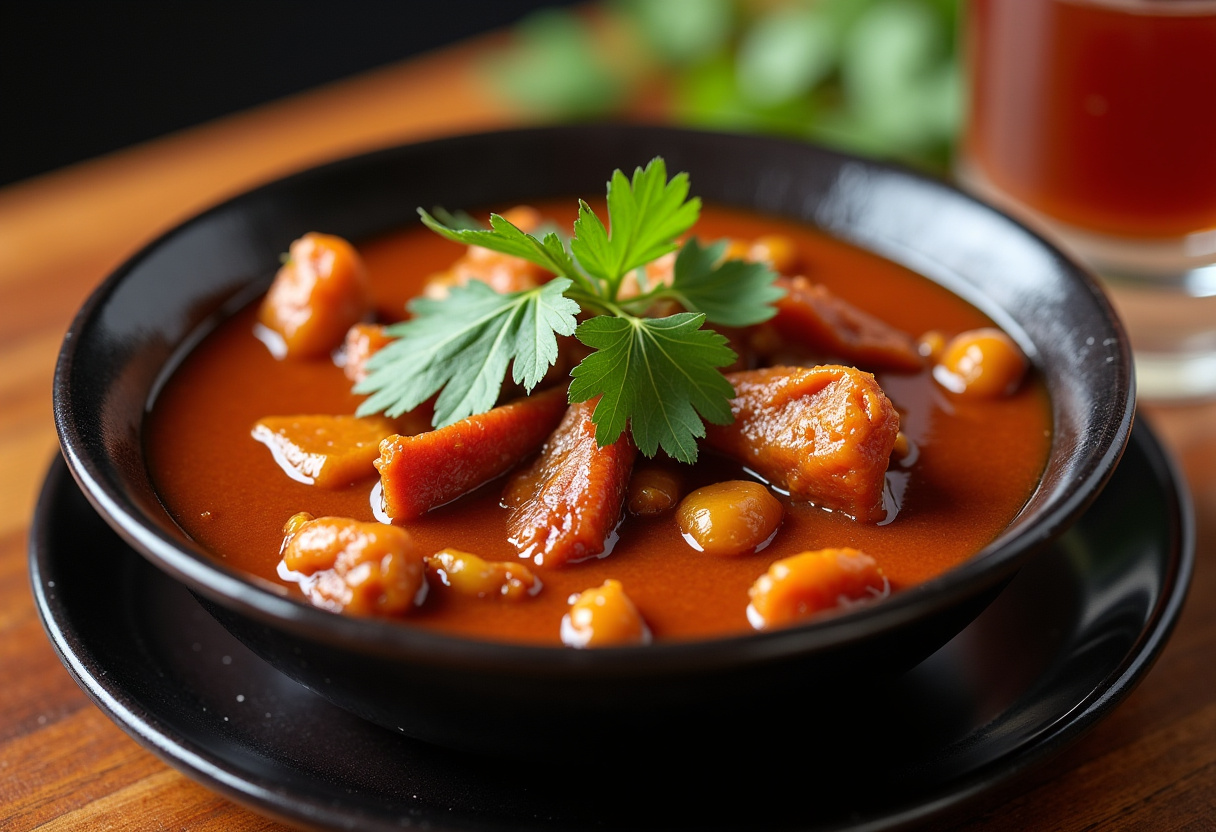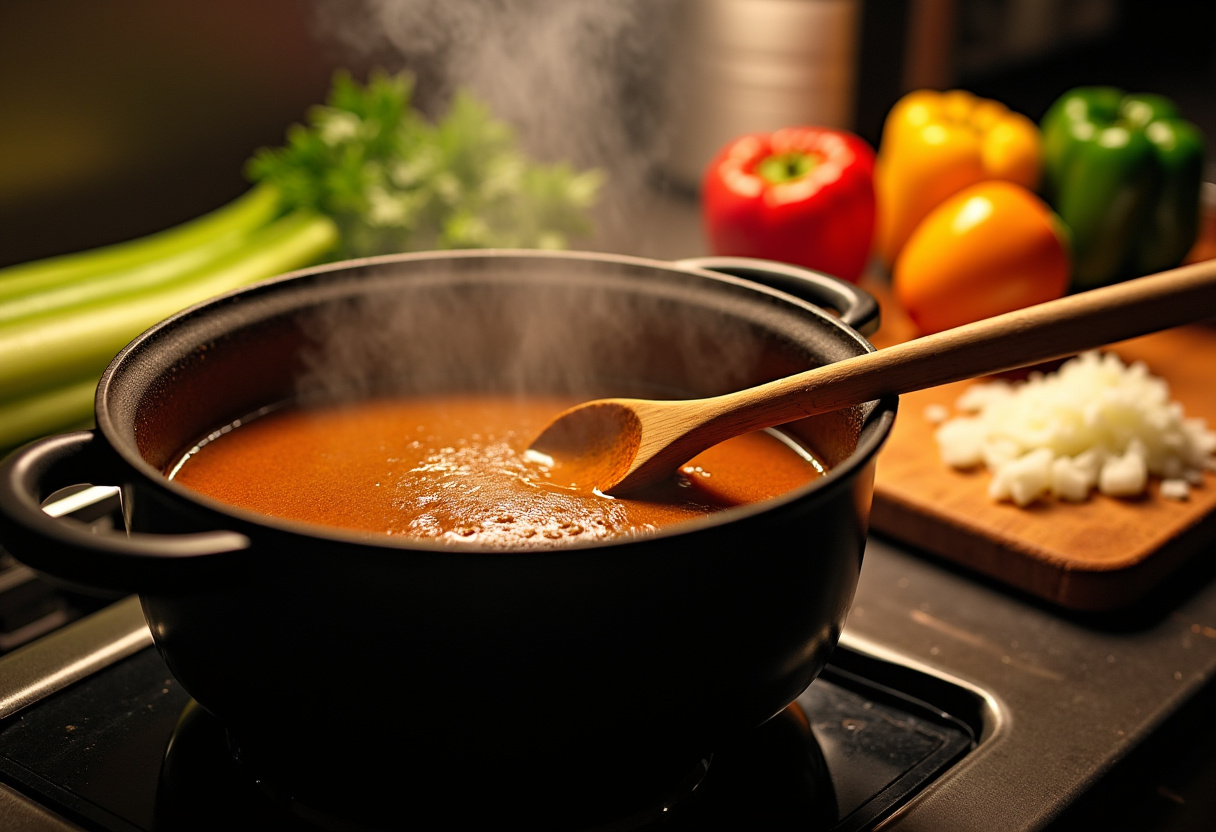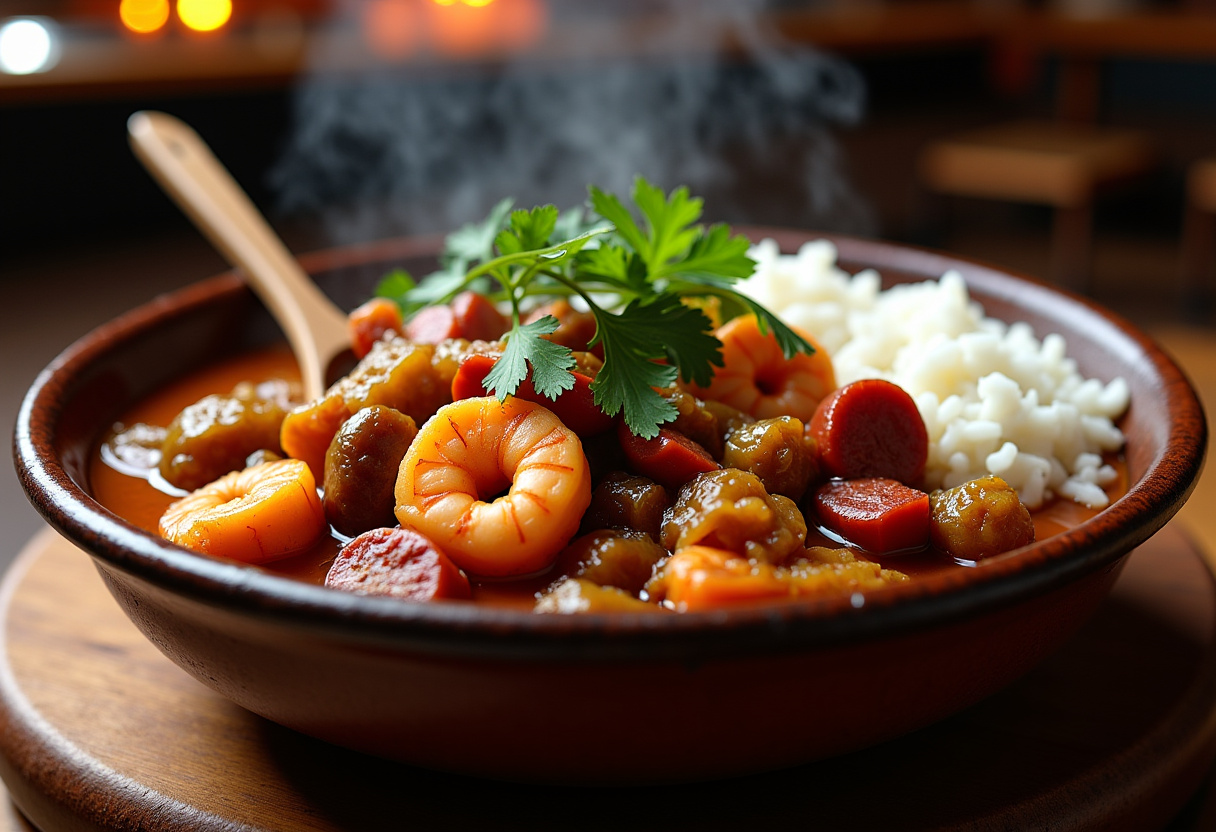Louisiana Gumbo: A Rich and Spicy Southern Masterpiece 🍲🔥✨
1. Introduction
Few dishes embody the soul of Southern cooking like a steaming bowl of authentic Louisiana gumbo. This rich, flavorful stew combines the best gumbo ingredients—succulent seafood, tender chicken, and spicy andouille sausage—in a dark, roux-thickened broth bursting with Cajun spices. Whether you’re craving a seafood gumbo recipe or a hearty chicken and sausage gumbo, this traditional dish delivers deep, complex flavors that warm you from the inside out.

Making gumbo from scratch might seem intimidating, but this easy gumbo recipe breaks it down into simple steps. From mastering the dark roux to layering flavors with the “holy trinity” (onions, bell peppers, and celery), you’ll learn how to make gumbo like a true Louisiana chef. Let’s dive into this homemade gumbo recipe that’s perfect for family dinners, Mardi Gras celebrations, or any day you crave bold Southern comfort food.
Step 1: Prepare the Roux (The Heart of Gumbo)
The foundation of any authentic Louisiana gumbo is its roux—a mixture of flour and fat cooked until deeply caramelized. For the best gumbo recipe, aim for a dark chocolate-brown roux, which adds incredible depth of flavor. In a heavy-bottomed pot or Dutch oven, heat ½ cup vegetable oil over medium heat. Gradually whisk in ½ cup all-purpose flour, stirring constantly to prevent burning. This process takes about 20-30 minutes; patience is key! The roux should smell nutty and reach the color of milk chocolate.
For those looking for alternative roux techniques, this classic Creole gumbo recipe from Allrecipes offers some excellent variations that might suit your cooking style better.

Step 2: Sauté the Holy Trinity
Once your roux reaches the perfect color, immediately add the “holy trinity” of Cajun cooking: 1 diced onion, 1 diced green bell pepper, and 2 stalks of diced celery. This aromatic base is essential for traditional gumbo. Stir the vegetables into the roux, coating them evenly. The mixture will sizzle and release incredible fragrances. Cook for 5-7 minutes until the vegetables soften. For extra flavor, add 3 minced garlic cloves in the last minute of cooking.
If you’re looking for more inspiration on Cajun cooking techniques, check out our collection of Southern dinner recipes that feature similar flavor profiles and cooking methods.

Step 3: Build the Flavor Base
Now it’s time to build your gumbo’s flavor profile. Stir in 1 pound of sliced andouille sausage and cook until lightly browned. Add 6 cups of chicken or seafood stock, 1 (14.5 oz) can of diced tomatoes, 2 bay leaves, and Cajun seasoning to taste (start with 1 tablespoon). For a seafood gumbo recipe, reserve shrimp and other seafood until later. Bring the mixture to a boil, then reduce heat and simmer for 30 minutes. If using okra (a traditional thickener), add 1 cup sliced now.
The key to perfect gumbo is in the layering of flavors. Start with a medium heat to allow all the ingredients to release their natural juices and aromas. The andouille sausage should render some of its fat into the mixture, adding another layer of flavor to your homemade gumbo. As the mixture simmers, you’ll notice the broth thickening slightly – this is when the magic really starts to happen!

Step 4: Add Proteins and Final Touches
For chicken and sausage gumbo, add 1 pound of boneless, skinless chicken thighs (cut into bite-sized pieces) and simmer for 15 minutes. For seafood gumbo, add 1 pound of peeled shrimp and 1 pint of shucked oysters in the last 5 minutes of cooking to prevent overcooking. Adjust seasoning with salt, pepper, and hot sauce. Remove bay leaves and stir in 2 tablespoons of chopped fresh parsley. Serve your homemade gumbo over steamed white rice, garnished with green onions and a sprinkle of filé powder (ground sassafras leaves) if desired.
When adding proteins, timing is everything. Chicken needs time to cook through, while seafood requires just enough heat to become opaque without turning rubbery. Many Louisiana cooks swear by adding the shrimp when the gumbo is just about done – they’ll continue to cook in the residual heat even after you’ve turned off the burner. This technique ensures perfectly cooked seafood in your gumbo every time.

9. Conclusion
This authentic Louisiana gumbo recipe brings the vibrant flavors of the Bayou to your kitchen. Whether you prefer seafood gumbo or the classic chicken and sausage version, mastering the dark roux and holy trinity ensures a rich, deeply flavored stew that’s truly the best gumbo you’ll ever taste. Remember, gumbo tastes even better the next day as flavors meld, making it perfect for meal prep or entertaining. Serve with crusty French bread, hot sauce, and plenty of Southern hospitality. Laissez les bon temps rouler—let the good times roll with this traditional gumbo that’s sure to become a family favorite!
For those who want to explore more Louisiana classics, why not try pairing your gumbo with some homemade cornbread or hush puppies? The combination of textures and flavors makes for an unforgettable Southern meal. And don’t forget – the beauty of gumbo lies in its versatility. Feel free to experiment with different proteins, spice levels, and vegetables to make this recipe your own!





No comment